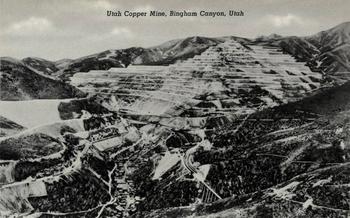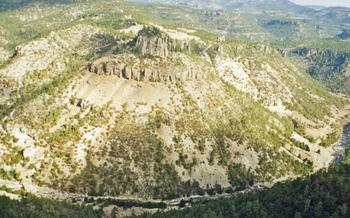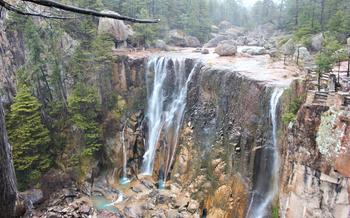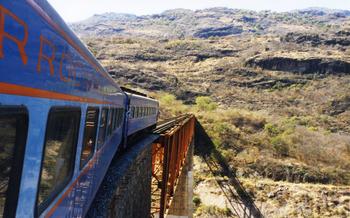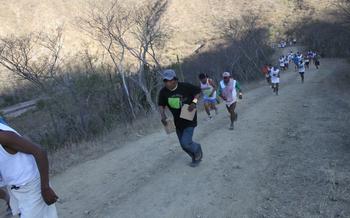
The Lost Cathedral of Satevó
- History of the Lost Cathedral of Satevó
- Location of the Lost Cathedral of Satevó
- Architectural Features of the Lost Cathedral of Satevó
- The Legend of the Lost Treasure of Satevó
- Restoration of the Lost Cathedral of Satevó
- Visiting the Lost Cathedral of Satevó
- Hiking to the Lost Cathedral of Satevó
- Cultural Significance of the Lost Cathedral of Satevó
- Local Legends and Folklore Surrounding the Lost Cathedral of Satevó
- The Lost Cathedral of Satevó as a Symbol of Resilience
- Conservation and Preservation of the Lost Cathedral of Satevó
- The Lost Cathedral of Satevó as a Destination for Adventure Travelers
- The Lost Cathedral of Satevó as a Place of Pilgrimage
- Insider Tip
History of the Lost Cathedral of Satevó
In the heart of the Copper Canyon, amidst the rugged landscapes and indigenous cultures of northern Mexico, lies a hidden gem: the Lost Cathedral of Satevó. Its story begins in the 17th century when Spanish missionaries, driven by their religious zeal, ventured into this remote region to spread the Catholic faith among the native tribes. In 1678, they founded the mission of San Francisco de Borja de Satevó, establishing a small settlement that would become the birthplace of the cathedral.
The construction of the cathedral, a testament to the missionaries' unwavering faith, commenced in the late 17th century. Using local materials such as adobe and stone, the builders created a magnificent structure that blended Spanish colonial and indigenous architectural styles. The cathedral's impressive size, despite its isolated location, reflected the missionaries' ambition to leave a lasting mark on the region.
However, the mission's prosperity was short-lived. In the early 18th century, the Spanish authorities decided to abandon the settlement due to the harsh living conditions and the dwindling number of missionaries. The once-thriving community was left deserted, and the cathedral fell into disrepair, its grandeur fading away with time.
Legends began to circulate among the local communities about the cathedral's hidden treasures. It was said that the Spanish missionaries, fearing attacks from hostile tribes, had buried a vast fortune in gold and jewels within the cathedral's walls. These stories fueled the imaginations of treasure hunters, who embarked on countless expeditions to uncover the elusive riches. However, despite their relentless efforts, the treasure remained undiscovered, solidifying the cathedral's reputation as the "Lost Cathedral of Satevó."
In the 20th century, the forgotten cathedral was rediscovered by a team of archaeologists and historians. They were captivated by its architectural beauty and historical significance and launched a restoration project to bring it back to its former glory. Through meticulous efforts and the use of traditional materials and techniques, the cathedral was painstakingly restored, revealing its hidden splendor once again. Today, the Lost Cathedral of Satevó stands as a testament to the resilience of faith and the enduring legacy of the Spanish colonial era in Mexico.
Location of the Lost Cathedral of Satevó
The Lost Cathedral of Satevó is nestled in the heart of the Copper Canyon region in the state of Chihuahua, Mexico. This awe-inspiring region is renowned for its dramatic landscapes, which include towering cliffs, deep canyons, and verdant valleys. The cathedral is situated near the town of Satevó, which serves as a gateway to this rugged and beautiful wilderness.
To reach the Lost Cathedral, visitors can either drive or embark on a scenic hike through the Copper Canyon. The drive takes approximately three hours from the city of Chihuahua, while the hike can take anywhere from two to three days, depending on the route and the pace of the hikers. The hike offers a unique opportunity to immerse oneself in the natural beauty of the canyon and experience the region's rich cultural heritage firsthand.
Architectural Features of the Lost Cathedral of Satevó
The Lost Cathedral of Satevó is a remarkable example of Spanish colonial architecture, with unique features that set it apart from other churches in the region. One of its most striking characteristics is the blend of Spanish and indigenous architectural styles. The cathedral's exterior features a simple and austere facade, typical of Spanish colonial churches, while the interior is adorned with intricate carvings and colorful murals, reflecting the influence of local indigenous cultures.
The cathedral's construction utilized local materials, such as adobe and stone, which have allowed it to withstand the harsh desert climate and remain in relatively good condition despite its age and abandonment. The impressive size and scale of the cathedral are also noteworthy, especially considering its remote location. Despite being situated in a rugged and isolated canyon, the cathedral's builders managed to create a structure of grandeur and scale that rivals many larger and more accessible churches.
The well-preserved condition of the cathedral is a testament to the skill and craftsmanship of its builders. Despite centuries of abandonment and exposure to the elements, the cathedral's walls, arches, and intricate carvings remain largely intact. This remarkable preservation has made the Lost Cathedral of Satevó a valuable historical and architectural treasure, offering a glimpse into Mexico's rich colonial past.
The Legend of the Lost Treasure of Satevó
One of the most enduring legends associated with the Lost Cathedral of Satevó is the belief that the Spanish missionaries hid a vast treasure within its walls before their departure. According to the legend, the treasure includes gold, silver, jewels, and other valuable artifacts. Over the centuries, numerous attempts have been made to find the treasure, but none have been successful. The legend has captured the imagination of treasure hunters and adventurers worldwide, and it continues to fuel the search for the lost treasure of Satevó.
The impact of the legend on the local culture and economy has been significant. It has attracted treasure hunters and tourists to the region, contributing to the local economy. The legend has also been a source of inspiration for local artists and storytellers, who have incorporated it into their works. The ongoing search for the treasure keeps the legend alive and adds an aura of mystery and excitement to the Lost Cathedral of Satevó.
Restoration of the Lost Cathedral of Satevó
In the 1970s, the Mexican government, in collaboration with local communities, embarked on an ambitious project to restore the Lost Cathedral of Satevó to its former glory. The restoration process was a complex and challenging undertaking, as the cathedral was in a state of disrepair and was located in a remote and inaccessible area.
The restoration team faced several challenges, including the need to use traditional materials and techniques to ensure the authenticity of the restoration. They also had to contend with the harsh weather conditions and the limited resources available in the region.
Despite these challenges, the restoration team persevered, and in 1979, the cathedral was reopened to visitors. The restoration was a success, and the cathedral is now a well-preserved example of Spanish colonial architecture, showcasing its unique blend of indigenous and European influences.
The restoration of the Lost Cathedral of Satevó is a testament to the dedication and perseverance of the Mexican government and the local communities. It is a symbol of the importance of preserving Mexico's cultural and historical heritage, and it has played a vital role in promoting tourism and economic development in the Copper Canyon region.
Visiting the Lost Cathedral of Satevó
Visiting the Lost Cathedral of Satevó is an experience that combines history, nature, and adventure. The cathedral is open to visitors daily, and a small admission fee is charged. It is highly recommended to hire a local guide to learn about the history and significance of the cathedral, as well as the surrounding area. Several tours and activities are available that incorporate a visit to the cathedral, ranging from guided hikes to horseback riding excursions. Visitors can also combine a visit to the cathedral with other attractions in the Copper Canyon region, such as the scenic train ride on the Chihuahua al Pacifico Railroad or a visit to the nearby town of Batopilas, known for its colonial architecture and silver mines.
Hiking to the Lost Cathedral of Satevó
For those seeking a more adventurous experience, hiking to the Lost Cathedral of Satevó through the Copper Canyon is an unforgettable journey. The hike offers stunning views of the rugged landscape and an intimate connection with the natural beauty of the region. While challenging, the rewards are immense, and the sense of accomplishment upon reaching the cathedral is unparalleled.
Proper preparation is essential for a successful hike. Sturdy hiking boots, comfortable clothing, and plenty of water are crucial. The terrain can be rough, and the weather can change quickly, so it's important to be prepared for anything. Hiking poles can provide additional support and stability, especially on uneven terrain.
The hike typically takes several days, depending on the route and pace. There are designated campsites along the way, allowing hikers to rest and recharge before continuing their journey. The opportunity to camp under the stars, surrounded by the breathtaking scenery of the Copper Canyon, is an experience in itself.
Along the hike, hikers will encounter various challenges, including steep climbs, river crossings, and narrow trails. However, the rewards are equally great. The stunning views from the rim of the canyon, the lush vegetation, and the diverse wildlife create a truly immersive experience.
Reaching the Lost Cathedral on foot is a moment of triumph. The sight of the majestic ruins, nestled amidst the rugged landscape, is awe-inspiring. The cathedral's unique architecture, its history, and its significance make it a truly special destination.
Hiking to the Lost Cathedral of Satevó is an adventure that combines physical challenges with cultural exploration and historical discovery. It's an experience that will stay with hikers long after they've returned home.
Cultural Significance of the Lost Cathedral of Satevó
The Lost Cathedral of Satevó holds immense cultural significance as a symbol of the region's religious and cultural heritage. It stands as a testament to the area's Spanish colonial past, showcasing the unique blend of Spanish and indigenous architectural styles that characterized the era. The cathedral's well-preserved condition, despite its age and abandonment, makes it a valuable reminder of the region's history and cultural traditions.
Recognizing its cultural importance, the Mexican government and local communities have made significant efforts to restore and preserve the cathedral. The restoration project aimed to maintain the authenticity of the building by using traditional materials and techniques, ensuring its historical integrity. The successful completion of the restoration has allowed the cathedral to reopen to visitors, providing an opportunity for people to experience and appreciate its cultural and historical significance firsthand.
The restoration of the Lost Cathedral of Satevó has also had a positive impact on the local economy. The cathedral has become a popular tourist attraction, drawing visitors from around the world who are eager to explore its history, architecture, and cultural significance. This influx of tourism has provided economic opportunities for local businesses and communities, fostering sustainable development and promoting cultural preservation in the region.
The Lost Cathedral of Satevó is not just a historical landmark but also a source of pride and identity for the people of the Copper Canyon region. Its enduring presence has shaped local culture and traditions, inspiring a deep sense of connection and reverence among the local communities. By preserving and promoting the cathedral, the people of the region are safeguarding their cultural heritage and ensuring its continued significance for generations to come.
Local Legends and Folklore Surrounding the Lost Cathedral of Satevó
The Lost Cathedral of Satevó is a place steeped in mystery and legend. One of the most enduring legends is that of the ghostly apparitions that are said to haunt the cathedral grounds. According to local folklore, the spirits of the Spanish missionaries who founded the mission can sometimes be seen wandering the ruins, dressed in their black robes and carrying lanterns.
Another popular legend tells of a hidden treasure that is buried somewhere on the cathedral grounds. It is said that the Spanish missionaries hid a vast fortune in gold and silver in the cathedral before their departure, and that the treasure has never been found. Many people have searched for the treasure over the years, but none have been successful.
The local people also believe that the cathedral is home to a variety of supernatural creatures, including ghosts, goblins, and witches. It is said that these creatures can be seen at night, wandering the ruins and playing tricks on visitors.
These legends and stories have been passed down through generations, and they continue to shape the local culture and identity. They add an air of mystery and intrigue to the Lost Cathedral of Satevó, and they make it a place that is both fascinating and a little bit frightening.
The Lost Cathedral of Satevó as a Symbol of Resilience
The Lost Cathedral of Satevó stands as a testament to the resilience of both the structure itself and the local people who have preserved it. Despite centuries of abandonment, neglect, and the harsh elements of the Copper Canyon, the cathedral has endured, its walls still standing tall and its intricate carvings still visible. This resilience is a reflection of the strength and determination of the people of the region, who have faced countless challenges throughout their history, including poverty, violence, and natural disasters. The cathedral serves as a reminder that even in the face of adversity, the human spirit can prevail. Its presence inspires people around the world to never give up on their dreams and to always strive for a better future.
Conservation and Preservation of the Lost Cathedral of Satevó
The Lost Cathedral of Satevó stands as a testament to the enduring power of human faith and architectural ingenuity. However, preserving this remote and historically significant building is a complex and ongoing challenge. The harsh desert environment, coupled with the cathedral's isolated location, makes it vulnerable to the elements and deterioration.
To protect the cathedral from further damage, the Mexican government and local communities have undertaken several conservation and restoration projects. These efforts have focused on stabilizing the structure, repairing damaged walls and roofs, and conserving the intricate artwork and religious artifacts that adorn the interior.
One of the challenges in conserving the cathedral is the lack of access to modern construction materials and equipment. To maintain the authenticity of the restoration, traditional materials and techniques are used whenever possible. Local craftsmen employ skills passed down through generations to replicate the original construction methods.
The conservation of the Lost Cathedral of Satevó is not just a matter of preserving a building but also of safeguarding a vital part of the region's cultural heritage. By protecting this iconic landmark, we ensure that future generations can continue to appreciate its beauty, history, and religious significance.
The Lost Cathedral of Satevó as a Destination for Adventure Travelers
The Lost Cathedral of Satevó holds a particular allure for adventure travelers, those intrepid souls who seek unique and off-the-beaten-path destinations. The cathedral's remote location, rugged surroundings, and historical significance make it an ideal destination for those seeking a challenging and rewarding adventure.
Reaching the cathedral requires a sense of adventure and a willingness to embrace the challenges of traveling in a remote and rugged region. The journey to Satevó can be arduous, involving long drives on winding roads, hikes through rugged canyons, and river crossings. However, the challenges are worth the reward, as the cathedral emerges from the landscape like a mirage, a testament to the resilience and determination of those who built it.
For adventure travelers, the Lost Cathedral of Satevó offers a unique blend of cultural exploration and historical discovery. Visitors can immerse themselves in the local culture by interacting with the friendly and welcoming people of the Copper Canyon region. They can learn about the history of the cathedral, the legends that surround it, and the ongoing efforts to preserve this remarkable site.
The sense of accomplishment that comes with reaching the Lost Cathedral of Satevó after a challenging journey is unparalleled. Whether hiking through the Copper Canyon or driving along the winding roads, the journey to the cathedral is an adventure in itself. And when you finally stand before this remote and awe-inspiring structure, you'll feel a sense of wonder and accomplishment that will stay with you long after your visit.
The Lost Cathedral of Satevó as a Place of Pilgrimage
The Lost Cathedral of Satevó holds a special place in the hearts of local Catholics. Each year, thousands of pilgrims flock to the cathedral during the annual pilgrimage, which is held on the feast day of Saint Francis of Assisi, the patron saint of the cathedral. For the faithful, the pilgrimage is an opportunity to pay homage to their patron saint, to seek his blessings, and to pray for his intercession. The pilgrimage is also a time for celebration, as the local community comes together to share food, music, and dance. Visitors to the cathedral during the pilgrimage can experience the vibrant religious traditions and customs of the region and witness the deep devotion of the local people to their faith.
Insider Tip
For the best experience when visiting the Lost Cathedral of Satevó, plan your trip during the dry season, which runs from October to April. During this time, the weather is typically mild and pleasant, making it ideal for exploring the cathedral and its surroundings. Additionally, the trails leading to the cathedral are generally passable during the dry season, ensuring a safe and enjoyable hike.
By visiting during the dry season, you can fully appreciate the beauty and significance of the Lost Cathedral of Satevó without having to worry about adverse weather conditions or impassable trails. Embrace the opportunity to immerse yourself in the history, culture, and natural wonders of this unique destination during its most favorable season.

